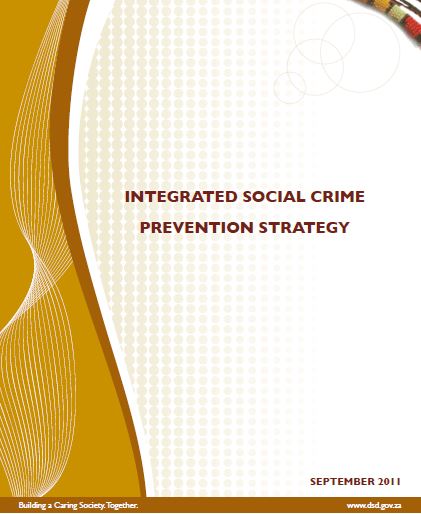Integrated Social Crime Prevention Strategy

Preventing crime has been a priority for all government departments and culminated in the launching of the NCPS in 1996. The NCPS emphasises the prevention of crime, rather than entirely relying on the criminal justice process to arrest and convict offenders. It is also based on the idea that the South African Police Service (SAPS) alone cannot reduce crime. Communities, NGOs, CBOs, FBOs and the respective government departments are equally responsible for reducing crime.
The NCPS has laid a foundation that provides regulations to various relevant departments to develop strategies that are aligned to existing approaches so as to avoid duplication of services. In dealing with crime, more emphasis is placed on an inter-sectoral and comprehensive approach. The NCPS also provides guidance to individual stakeholders on different programmes, as it is the result of an extensive process of research and analysis, and has drawn on international experiences. The role and responsibilities of government departments is, however to deal with difficult conditions facing children, youth, men and women, specifically those that relate to criminal activity. Concerted efforts need to be directed at addressing the underlying causes of delinquency, violence and crime, rather than reacting to symptoms and emergency needs.
The provision of services, such as basic education, healthcare, job opportunities and recreation in rural and urban areas will contribute to children’s early growth, development, functioning and progress in society. There is, therefore, a dire need to provide integrated and coordinated programmes through the guidance of the Integrated Social Crime Prevention Strategy. The rationale for developing and implementing the Integrated Social Crime Prevention Strategy is to enable the government departments to respond to crime-related issues in a coordinated and focused manner, specifically looking at issues causing crime. The strategy will also promote joint efforts for creating a common understanding and vision on how to combat crime, bringing together concerted interventions within government departments as crucial initiatives for social crime prevention.
Furthermore, the strategy aims to maximise the participation of communities and civil society organisations in the mobilisation and creation of a dedicated and integrated crime prevention capacity, aimed at conducting ongoing research and evaluation of departmental and public campaigns. The Integrated Strategy entails a professional and civil movement, governed and supported by respective departments, which enhances the self-defense capabilities of society. It is a set of objectives to curb the effects of the underlying causes of crime, reduce the risk of becoming a victim, raise the safety of the community as a whole, and thus improve quality of life and human rights. An integrated framework is also provided in this document to enable departments to fulfill their role and mandate of prioritising social crime prevention at all levels of intervention, as outlined in the Integrated Service Delivery Model (2005).
While more focus is placed on both primary and secondary prevention, tertiary prevention is also addressed to avert reoccurrences of criminal activities. Primary prevention refers to aspects that will address risk factors in the general population known to be associated with criminal trends, such as youth unemployment or lack of economic opportunities for women. It is aimed at strengthening and building capacity and self-reliance in a child within the family by providing public education and awareness campaigns, strengthening community-based responses and family preservation, and ensuring that childrenremain in school. This includes the departments’ aims of making social grants accessible to all those who qualify. The introduction of the Extended Public Works Programme (EPWP) is also one of the government’s poverty alleviation programmes targeting unemployed young people and their families. The purpose of the EPWP is to create jobs with career paths and reduce unemployment in the long-term, while improving the quality of services.
Secondary prevention refers to aspects that target situations where people or neighbourhoods are particularly at risk, such as helping youth at risk, or providing extra public health nurses for teenage mothers in disorganised communities. Services delivered at this level make use of developmental and therapeutic programmes to ensure that children who have been identified as being at risk are assisted before they require statutory services, which are more intensive. Tertiary prevention refers to strategies that prevent recidivism by assisting with the social reintegration of offenders and other preventive mechanisms (reintegration programmes), as prescribed in Chapter 8 of the Children’s Act (Act 41 of 2007).
The following prescripts were viewed as background for the development of the Integrated Social Crime Prevention Strategy (ISCPS): The Constitution of the Republic of South Africa (Act 108 of 1996); NCPS, 1996; White Paper for Safety and Security, 1998; White Paper on Local Government, 1998; White Paper for Social Welfare, 1997; Welfare Laws Amendment Act (Act 106 of 1997); Social Assistance Act (Act 13 of 2004); Regulations relating to the Social Assistance Act (Act 13 of 2004); Norms and Standards for Developmental Social Welfare Services; Strategic Plan 2008–2011; Tenpoint Plan and many other sources listed in Annexure ‘A’ and the references. By means of in-depth research, extensive consultation and the framework, six strategic objectives were developed, which further channelled the development of a comprehensive and integrated action plan for government departments. The following are the six strategic objectives:
• Strengthening internal and external capacity to sustain better service delivery.
• Facilitating targeted collaborative partnership with other government departments and civil society organisations.
• Ensuring equitable and integrated site-based service delivery for local service providers.
• Promoting sustained institutional mechanisms in communities.
• Improving social fabric and cohesion within families.
• Ensuring investment in prevention and early intervention services with long-term benefits.
The six strategic objectives and programmes are condensed to serve as a premise for communicating an integrated mandate to individuals, families and communities, whereas the matrix identifies the roles and responsibilities of government departments. Given the magnitude of the demand of social crime prevention initiatives, the implementation of the strategy will be aimed at promoting the provision of an integrated service delivery approach to facilitate community safety and social crime prevention. In addition, capacity within government departments will be enhanced, in order to execute collective core functions through an integrated action plan, as outlined in Part ‘B’. The Department of Social Development is the focal role-player to lead other departments to effectively and efficiently implement the Integrated Social Crime Prevention Strategy. Furthermore, the department of social development will also be responsible for facilitating development of the monitoring and evaluation mechanism for the implementation and indicators.


Comments